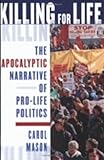Killing for Life : The Apocalyptic Narrative of Pro-Life Politics / Carol Mason.
Material type: TextPublisher: Ithaca, NY : Cornell University Press, [2018]Copyright date: ©2002Description: 1 online resource (264 p.) : 8 halftonesContent type:
TextPublisher: Ithaca, NY : Cornell University Press, [2018]Copyright date: ©2002Description: 1 online resource (264 p.) : 8 halftonesContent type: - 9781501724671
- 363.46/0973 21
- HQ767.5.U5 M365 2002
- online - DeGruyter
| Item type | Current library | Call number | URL | Status | Notes | Barcode | |
|---|---|---|---|---|---|---|---|
 eBook
eBook
|
Biblioteca "Angelicum" Pont. Univ. S.Tommaso d'Aquino Nuvola online | online - DeGruyter (Browse shelf(Opens below)) | Online access | Not for loan (Accesso limitato) | Accesso per gli utenti autorizzati / Access for authorized users | (dgr)9781501724671 |
Frontmatter -- Contents -- Acknowledgments -- Introduction -- 2. From Protest to Retribution -- 3. Protection from and for the Fetal Citizen -- 4. The Gideon Story -- 5. Making Time for America's Armageddon -- 6. Narrating Enemies -- Conclusion -- Notes -- Selected Bibliography -- Index
restricted access online access with authorization star
http://purl.org/coar/access_right/c_16ec
How can those who seek to protect the "right to life" defend assassination in the name of saving lives? Carol Mason investigates this seeming paradox by examining pro-life literature—both archival material and writings from the front lines of the conflict. Her analysis reveals the apocalyptic thread that is the ideological link between established anti-abortion organizations and the more shadowy pro-life terrorists who subject clinic workers to anthrax scares, bombs, and bullets.The portrayal of abortion as "America's Armageddon" began in the 1960s. In the 1970s, Mason says, Christian politics and the post-Vietnam paramilitary culture popularized the idea that legal abortion is a harbinger of apocalypse. By the 1990s, Mason asserts, even the movement's mainstream had taken up the call, narrating abortion as an apocalyptic battle between so-called Christian and anti-Christian forces. "Pro-life violence of the 1990s signaled a move away from protest and toward retribution," she writes. "Pro-life retribution is seen as a way to restore the order of God. In this light, the phenomenon of killing for 'life' is revealed not as an oxymoron, but as a logical consistency and a political manifestation of religious retribution."Mason's scrutiny of primary sources (direct mail, internal memoranda, personal letters, underground manuals, and pro-life films, magazines, and novels) draws attention to elements of pro-life millennialism. Killing for Life is a powerful indictment of pro-life ideology as a coherent, mass-produced narrative that does not merely condone violence, but anticipates it as part of "God's plan."
Mode of access: Internet via World Wide Web.
In English.
Description based on online resource; title from PDF title page (publisher's Web site, viewed 26. Apr 2024)


